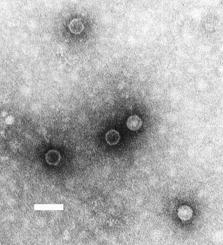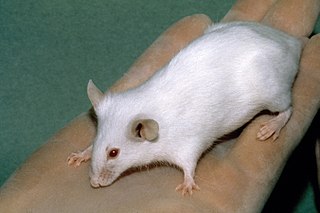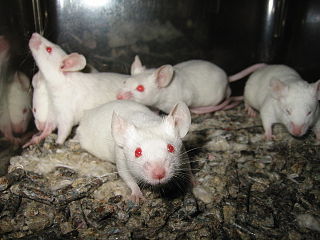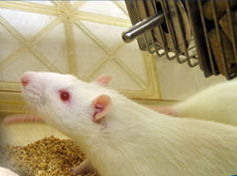Related Research Articles

Poliovirus, the causative agent of polio, is a member virus of Enterovirus C, in the family of Picornaviridae.
Inbred strains are individuals of a particular species which are nearly identical to each other in genotype due to long inbreeding. A strain is inbred when it has undergone at least 20 generations of brother x sister or offspring x parent mating, at which point at least 98.6% of the loci in an individual of the strain will be homozygous, and each individual can be treated effectively as clones. Some inbred strains have been bred for over 150 generations, leaving individuals in the population to be isogenic in nature. Inbred strains of animals are frequently used in laboratories for experiments where for the reproducibility of conclusions all the test animals should be as similar as possible. However, for some experiments, genetic diversity in the test population may be desired. Thus outbred strains of most laboratory animals are also available, where an outbred strain is a strain of an organism that is effectively wildtype in nature, where there is as little inbreeding as possible.

The laboratory mouse is a small mammal of the order Rodentia which is bred and used for scientific research. Laboratory mice are usually of the species Mus musculus. They are the most commonly used mammalian research model and are used for research in genetics, psychology, medicine and other scientific disciplines. Mice belong to the Euarchontoglires clade, which includes humans. This close relationship, the associated high homology with humans, their ease of maintenance and handling, and their high reproduction rate, make mice particularly suitable models for human-oriented research. The laboratory mouse genome has been sequenced and many mouse genes have human homologues.

Adult T-cell leukemia/lymphoma is a rare cancer of the immune system's T-cells caused by human T cell leukemia/lymphotropic virus type 1 (HTLV-1).

A nude mouse is a laboratory mouse from a strain with a genetic mutation that causes a deteriorated or absent thymus, resulting in an inhibited immune system due to a greatly reduced number of T cells. The phenotype of the mouse is a lack of body hair, which gives it the "nude" nickname. The nude mouse is valuable to research because it can receive many different types of tissue and tumor grafts, as it mounts no rejection response. These xenografts are commonly used in research to test new methods of imaging and treating tumors. The genetic basis of the nude mouse mutation is a disruption of the FOXN1 gene.

The Jackson Laboratory is an independent, nonprofit biomedical research institution dedicated to contributing to a future of better health care based on the unique genetic makeup of each individual. With more than 2,100 employees in Bar Harbor, Maine; Sacramento, California; and at a new genomic medicine institute in Farmington, Connecticut; the Laboratory's mission is to discover precise genomic solutions for disease and empower the global biomedical community in the shared quest to improve human health. The institution is a National Cancer Institute-designated Cancer Center and has NIH centers of excellence in aging and systems genetics.
A transgene is a gene that has been transferred naturally, or by any of a number of genetic engineering techniques from one organism to another. The introduction of a transgene (catransgenesis") has the potential to change the phenotype of an organism. Transgene describes a segment of DNA containing a gene sequence that has been isolated from one organism and is introduced into a different organism. This non-native segment of DNA may either retain the ability to produce RNA or protein in the transgenic organism or alter the normal function of the transgenic organism's genetic code. In general, the DNA is incorporated into the organism's germ line. For example, in higher vertebrates this can be accomplished by injecting the foreign DNA into the nucleus of a fertilized ovum. This technique is routinely used to introduce human disease genes or other genes of interest into strains of laboratory mice to study the function or pathology involved with that particular gene.

Microinjection is the use of a glass micropipette to inject a liquid substance at a microscopic or borderline macroscopic level. The target is often a living cell but may also include intercellular space. Microinjection is a simple mechanical process usually involving an inverted microscope with a magnification power of around 200x.

C57BL/6, often referred to as "C57 black 6", "C57" or "black 6", is a common inbred strain of laboratory mouse.
In genetics, two organisms that differ in only one locus and a linked segment of chromosome are defined as congenic. Similarly, organisms that are coisogenic differ in one locus only and not in the surrounding chromosome. Unlike congenic organisms, coisogenic organisms cannot be bred and only occur through spontaneous or targeted mutation at the locus.

BALB/c is an albino, laboratory-bred strain of the house mouse from which a number of common substrains are derived. Now over 200 generations from New York in 1920, BALB/c mice are distributed globally, and are among the most widely used inbred strains used in animal experimentation.

The history of model organisms began with the idea that certain organisms can be studied and used to gain knowledge of other organisms or as a control (ideal) for other organisms of the same species. Model organisms offer standards that serve as the authorized basis for comparison of other organisms. Model organisms are made standard by limiting genetic variance, creating, hopefully, this broad applicability to other organisms.

Rod cGMP-specific 3',5'-cyclic phosphodiesterase subunit beta is the beta subunit of the protein complex PDE6 that is encoded by the PDE6B gene. PDE6 is crucial in transmission and amplification of visual signal. The existence of this beta subunit is essential for normal PDE6 functioning. Mutations in this subunit are responsible for retinal degeneration such as retinitis pigmentosa or congenital stationary night blindness.

A knockout rat is a genetically engineered rat with a single gene turned off through a targeted mutation used for academic and pharmaceutical research. Knockout rats can mimic human diseases and are important tools for studying gene function and for drug discovery and development. The production of knockout rats was not economically or technically feasible until 2008.
Genetically modified mammals are mammals that have been genetically engineered. They are an important category of genetically modified organisms. The majority of research involving genetically modified mammals involves mice with attempts to produce knockout animals in other mammalian species limited by the inability to derive and stably culture embryonic stem cells.

Jacqueline N. Crawley is an American behavioral neuroscientist and an expert on rodent behavioral analysis. Since July 2012, she is the Robert E. Chason Chair in Translational Research at the University of California, Davis School of Medicine and the UC Davis MIND Institute. Previously, from 1983-2012, she was chief of the Laboratory of Behavioral Neuroscience in the intramural program of the National Institute of Mental Health. Her translational research program focuses on testing hypotheses about the genetic causes of autism spectrum disorders and discovering treatments for the diagnostic symptoms of autism, using mouse models. She has published more than 260 peer-reviewed articles in scientific journals and over 100 review articles and book chapters. According to the Web of Science, her works have been cited over 16,000 times, giving her an h-index of 72. She has co-edited 4 books and is the author of What's Wrong With my Mouse, which was very well received.
Michael Menaker, is an American chronobiology researcher, currently serving Commonwealth Professor of Biology at University of Virginia. His research focuses on circadian rhythmicity of vertebrates, including contributing to an understanding of light input pathways on extra-retinal photoreceptors of non-mammalian vertebrates, discovering a mammalian mutation for circadian rhythmicity, and locating a circadian oscillator in the pineal gland of bird. He has written almost 200 scientific publications.
Breast cancer metastatic mouse models are experimental approaches in which mice are genetically manipulated to develop a mammary tumor leading to distant focal lesions of mammary epithelium created by metastasis. Mammary cancers in mice can be caused by genetic mutations that have been identified in human cancer. This means models can be generated based upon molecular lesions consistent with the human disease.
Abbie E. C. Lathrop was a rodent fancier who bred fancy mice.
Clara J. Lynch was an American biologist and cancer researcher, who notably pioneered the use of the Swiss laboratory mouse in cancer research.
References
- ↑ FVB Mouse [ permanent dead link ] | Charles River. (2017). Criver.com. Retrieved 24 November 2017.
- ↑ Festing, M. (1998). MGI – Inbred Strains: FVB. Informatics.jax.org. Retrieved 24 November 2017.
- 1 2 3 FVB/NJ. (2017). Retrieved 24 November 2017.
- 1 2 Pugh, P., Ahmed, S., Smith, M., Upton, N., & Hunter, A. (2004). A behavioural characterisation of the FVB/N mouse strain. Behavioural Brain Research , 155(2), 283–289.
- ↑ Taketo, M., Schroeder, A., Mobraaten, L., Gunning, K., Hanten, G., & Fox, R. et al. (1991). FVB/N: an inbred mouse strain preferable for transgenic analyses. Proceedings Of The National Academy Of Sciences, 88(6), 2065–2069.
- ↑ Mahler, J., Stokes, W., Mann, P., Takaoka, M., & Maronpot, R. (1996). Spontaneous Lesions in Aging FVB/N Mice. Toxicologic Pathology , 24(6), 710–716.
- ↑ FVB.129P2-Pde6b+ Tyrc-ch/AntJ. (2017). jax.org. Retrieved 24 November 2017.